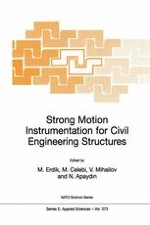2001 | OriginalPaper | Buchkapitel
Seismic Monitoring of Nuclear Power Plants; An Approach to Optimal and More Accurate Seismic Data Processing and Interpretation Procedure
verfasst von : D. M. Dojcinovski, D. J. Mamucevski, V. P. Mihailov
Erschienen in: Strong Motion Instrumentation for Civil Engineering Structures
Verlag: Springer Netherlands
Enthalten in: Professional Book Archive
Aktivieren Sie unsere intelligente Suche, um passende Fachinhalte oder Patente zu finden.
Wählen Sie Textabschnitte aus um mit Künstlicher Intelligenz passenden Patente zu finden. powered by
Markieren Sie Textabschnitte, um KI-gestützt weitere passende Inhalte zu finden. powered by
The seismic monitoring systems on NPP-s have two main functions: (1) to provide recorded accurate data on seismic input and dynamic behaviour of structures and the vital hardlines and processing control and protection systems, and (2) to enable automatic alarm, and, in some cases, automatic stoppage of the processes that go on in NPP-s in case of earthquakes with intensities higher than the previously defined values. The exact records of the seismic input and dynamic response are important from two aspects: (1) they should enable fast inspection of NPP-s after earthquakes and (2) they should enable checking of the previous design and analytical models for definition of the seismic safety of the NPP-s.The new regulations for seismic design of NPP-s anticipates a complex concept for definition of intensity of seismic motion. Apart from amplitudes (peak acceleration) and frequency characteristics (dominant frequencies), the new regulations consider also the energy characteristics (cumulative absolute velocity).Presented in the paper is a concept for processing of accelerogrammes based on comparative analysis of two software packages: Kinemetrics SWS (Seismic Work Station) and the procedure developed at the Institute of Earthquake Engineering and Engineering Seismology. Both concepts are based on the same theoretical basis and represents derivatives of the main procedure developed at CALTECH Institute from Pasadena, USA.Elaborated is a concept for definition of the input parameters; band-pass filter comer frequencies and slopes, elimination of DC components in the recorded accelerograms and calculation and selection of 100 most relevant values of frequencies for calculation of response spectra. Used as seismic input were two types of data: recorded accelerogrammes generated by biaxial shaking table (the applied acceleration and displacement time histories were used as reference and comparative signals) and “in situ” record of blast experiments.
